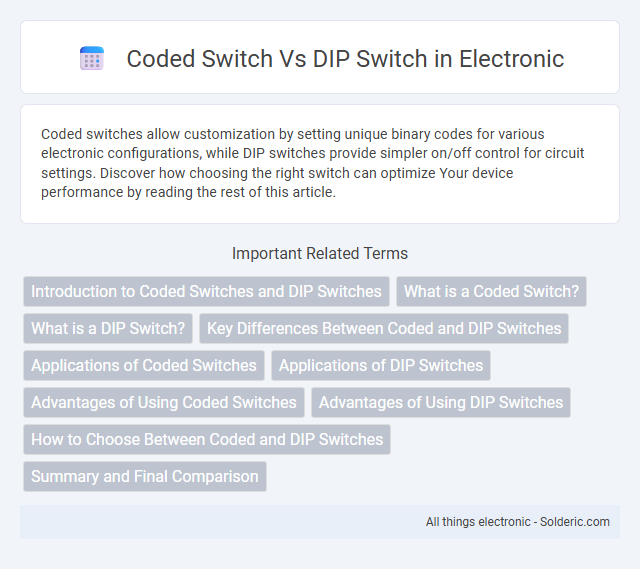Coded switches allow customization by setting unique binary codes for various electronic configurations, while DIP switches provide simpler on/off control for circuit settings. Discover how choosing the right switch can optimize Your device performance by reading the rest of this article.
Comparison Table
| Feature | Coded Switch | DIP Switch |
|---|---|---|
| Definition | A switch with pre-set coded patterns, used for device addressing. | A manual switch with multiple small levers for binary settings. |
| Usage | Primarily in security systems, remote control devices. | Common in electronics for configuration and mode selection. |
| Operation | Selects codes by rotating or sliding to specific positions. | Toggle individual switches ON/OFF to set binary values. |
| Number of Positions | Usually 10 positions (0-9) per switch. | Typically 2 positions (ON/OFF) per switch. |
| Complexity | Offers coded addressing; more complex combinations. | Simple binary combinations for setting options. |
| Durability | Robust; designed for less frequent adjustments. | Durable; designed for ease of multiple toggles. |
| Typical Applications | Alarm systems, remote controls, security codes. | Computer hardware, communication devices, instrumentation. |
Introduction to Coded Switches and DIP Switches
Coded switches and DIP switches are essential components used for setting electronic device configurations. Coded switches offer a unique binary or hexadecimal code output, enabling precise digital input selections, while DIP switches provide multiple on/off toggle positions for manual circuit control. Both switches serve as reliable options for device addressing, mode selection, and system customization in various electronic applications.
What is a Coded Switch?
A coded switch is a compact, multi-position rotary switch used for setting digital signals or selecting specific circuit configurations based on binary or decimal codes. Unlike DIP switches, which use multiple individual toggle switches, coded switches provide a single dial or knob that can be rotated to various preset positions, each corresponding to a unique code or value. These switches are commonly used in electronic devices for address selection, mode setting, and hardware configuration tasks.
What is a DIP Switch?
A DIP switch is a manual electrical component consisting of a series of small switches packaged in a dual in-line package, used to configure settings on electronic devices. It allows users to customize hardware behavior by toggling individual switches to represent binary data, making it ideal for setting device options without software. You can easily adjust DIP switch positions to control device functions such as hardware addresses, modes, or feature activation.
Key Differences Between Coded and DIP Switches
Coded switches use a binary or hexadecimal code that allows for more complex and customizable configurations compared to DIP switches, which operate with a simple ON/OFF mechanism for basic settings. DIP switches are typically used for straightforward device addressing and selection, while coded switches provide enhanced functionality in applications requiring multiple combination inputs. The key difference lies in coded switches offering higher resolution and flexibility, whereas DIP switches prioritize ease of use and quick hardware configuration.
Applications of Coded Switches
Coded switches are widely used in security systems, telecommunications, and industrial machinery for precise configuration and control settings. Their ability to provide unique binary combinations makes them ideal for encoding user-specific options in devices like alarm systems and remote controls. You can leverage coded switches to ensure reliable switch identification and reduce errors in system programming.
Applications of DIP Switches
DIP switches are widely used in applications requiring simple manual configuration settings, such as setting hardware addresses on network devices, configuring options on motherboards, or controlling modes on industrial machines. Their ease of use and reliability make them ideal for embedded systems, telecommunications equipment, and home automation controls. You can quickly customize device behavior without needing software or complex programming.
Advantages of Using Coded Switches
Coded switches offer precise settings with reduced risk of accidental changes, enhancing reliability in electronic configurations. Their unique coding prevents incorrect selection, ensuring consistent device performance and easier troubleshooting. These advantages make coded switches ideal for complex systems requiring secure and error-free operation.
Advantages of Using DIP Switches
DIP switches offer easy manual configuration and reliable binary settings without the need for programming, making them ideal for hardware-level adjustments. Their compact design enables efficient integration into circuit boards, providing stable and tamper-resistant settings in industrial and consumer electronics. DIP switches also reduce setup time and minimize the risk of errors compared to coded switches, enhancing operational consistency.
How to Choose Between Coded and DIP Switches
Choosing between coded switches and DIP switches depends on application requirements for precision and complexity; coded switches provide binary-coded outputs ideal for digital systems requiring multi-bit data input, while DIP switches offer simpler on/off configurations suitable for basic device settings and hardware configurations. Consider the voltage and current ratings, size constraints, and ease of integration with existing circuit designs to determine the appropriate switch type. Evaluate environmental factors like durability and exposure to contaminants, as DIP switches often feature more robust mechanical designs, whereas coded switches excel in compact, high-density applications.
Summary and Final Comparison
Coded switches use binary or hexadecimal codes to set multiple configurations precisely, making them ideal for complex electronic applications requiring easy reprogramming. DIP switches offer straightforward ON/OFF settings with simple mechanical toggles, preferred in simpler or legacy systems for manual control. Your choice depends on whether you need flexible coding or basic switching functionality, balancing complexity and ease of use.
Coded switch vs DIP switch Infographic

 solderic.com
solderic.com